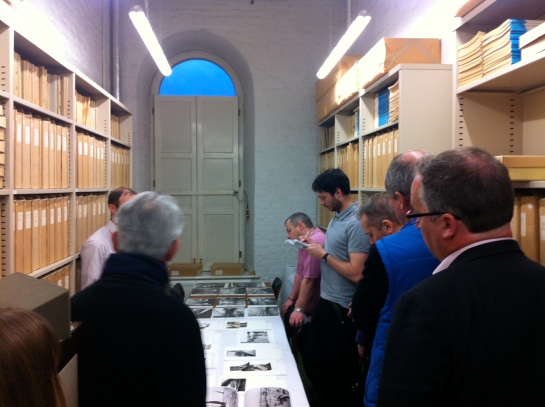It was a wet and windy re-union for the Curate the Collection gang as we met on a blustery Thursday evening at the Dial Arch pub in Woolwich. Once assembled and after a few swift pints the group were ready to explore the Brass Foundry photographic archives. It was apparent that each member of the group had different expectations from the visit with many, including myself hoping for unlimited time and access to pilfer the riches of the collection.
The Brass Foundry building is itself steeped in maritime history and was built in 1716 as a response to low stocks of artillery in the surrounding area. Throughout the years the Foundry has undergone numerous changes, incorporating the latest technology of the day they produced and supplied the majority of weaponry and artillery to the British Armed Forces.
Upon entering the Foundry we met Jeremy Michell, the manager of the National Maritime’s Historic photographs and ship plans. We were given an extensive guided tour of the Foundry and I was amazed to discover the sheer quantity of the collection – some 300,000 historic negatives, 1500 albums and one million ship plans are housed here.
Jeremy explained the complex processes involved with the upkeep and maintenance of the fragile collection, such as maintaining the correct room temperature and using protective casing for the negatives. The oldest negative in the collection is a waxed paper negative of Brunel’s Great Britain taken in 1844. We were able to view some of the oldest items in the collection including a badly damaged glass plate image depicting Scarborough beach. We heard a series of anecdotes describing finding negatives in skips, derelict buildings and receiving anonymous donations – often these donated and acquired pieces have no annotation and are badly damaged, making cataloguing practically impossible.

Unfortunately only a minute proportion of the physical collection has been digitalised and is currently accessible to the public. This is available on-line via Flickr Commons or through the Historic photographs. Unfortunately the digitalisation process within Museum environment takes a significant amount of time and generally this selection process is dictated by a photograph’s relevance to an upcoming exhibition. In this regard we viewed a series of recently digitalised maritime images that had been exhibited from photographers: Tarry Adams, Bedford Lemere and Alan Villiers. Individual access to the collection is available to general public or for researching students but only by appointment.
It is frightening to imagine what treasures will never see the light of day from the collection at the Brass Foundry. I got the sense that the Curators and the National Maritime Museum in general see these images as closely guarded historical documents and as such offer insight location, historical events and people in the image. There seems to be a lack of artistic appreciation for the variety of unusual and standalone images in the collection, raising an important question concerning the value attributed to each photograph when interpreted by an audience with different aesthetic interests. Our project demonstrates just one way that this ‘nautical’ collection can be used to explore themes such as the ‘weather’, ‘journeys’ or the ‘the unusual’.
The creative process that we have implemented when short-listing images for display in the Compass Lounge helps question the limits of classifying this collection as simply a photographic record.
In my opinion it is the ‘unknown’ quality of photography that initially inspires engagement and subsequently this process encourages an exploration of our own identity and how we as individuals create meaning. This is just one interpretation of the photographs, but this highlights how wide-reaching potentially this collection could have on research or as an artistic tool.
Promoting the collection more widely and using it for unexpected purposes such as the Flickr Commons is one way of broadening its appeal and giving the collection greater exposure.
Duncan


